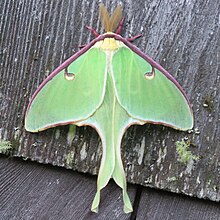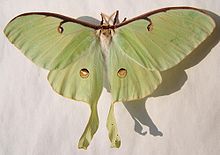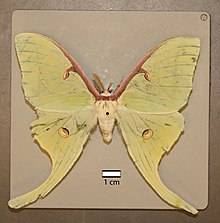| Luna moth | |
|---|---|

| |
| Male | |

| |
| Female | |
| Scientific classification | |
| Domain: | Eukaryota |
| Kingdom: | Animalia |
| Phylum: | Arthropoda |
| Class: | Insecta |
| Order: | Lepidoptera |
| Family: | Saturniidae |
| Genus: | Actias |
| Species: | A. luna
|
| Binomial name | |
| Actias luna | |

The luna moth (Actias luna), also called the American moon moth, is a Nearctic moth in the family Saturniidae, subfamily Saturniinae, a group commonly named the giant silk moths.
The moth has lime-green wings and a white body. Its caterpillars are also green. Its typical wingspan is roughly 114 mm (4.5 in), but wingspans can exceed 178 mm (7.0 in), ranking the species as one of the larger moths in North America.
Across Canada, it has one generation per year, with the winged adults appearing in late May or early June, whereas farther south it will have two or even three generations per year, the first appearance as early as March in southern parts of the United States.[2]
As defense mechanisms, larvae emit clicks as a warning and can also regurgitate intestinal contents, confirmed as having a deterrent effect on a variety of predators.[3] The elongated tails of the hindwings are thought to confuse the echolocation detection used by predatory bats.[4][5]
A parasitoid fly deliberately introduced to North America as a biological pest control for the invasive species spongy moth (formerly known as gypsy moth) appears to have had a negative impact on luna moths and other native moths.[6][7]
- ^ "NatureServe Explorer 2.0". explorer.natureserve.org. Retrieved 20 June 2022.
- ^ Cite error: The named reference
Tuskes1996was invoked but never defined (see the help page). - ^ Cite error: The named reference
Brown2007was invoked but never defined (see the help page). - ^ Cite error: The named reference
Lee2016was invoked but never defined (see the help page). - ^ Cite error: The named reference
Barber2015was invoked but never defined (see the help page). - ^ Cite error: The named reference
Elkinton2004was invoked but never defined (see the help page). - ^ Cite error: The named reference
Kellogg2003was invoked but never defined (see the help page).
